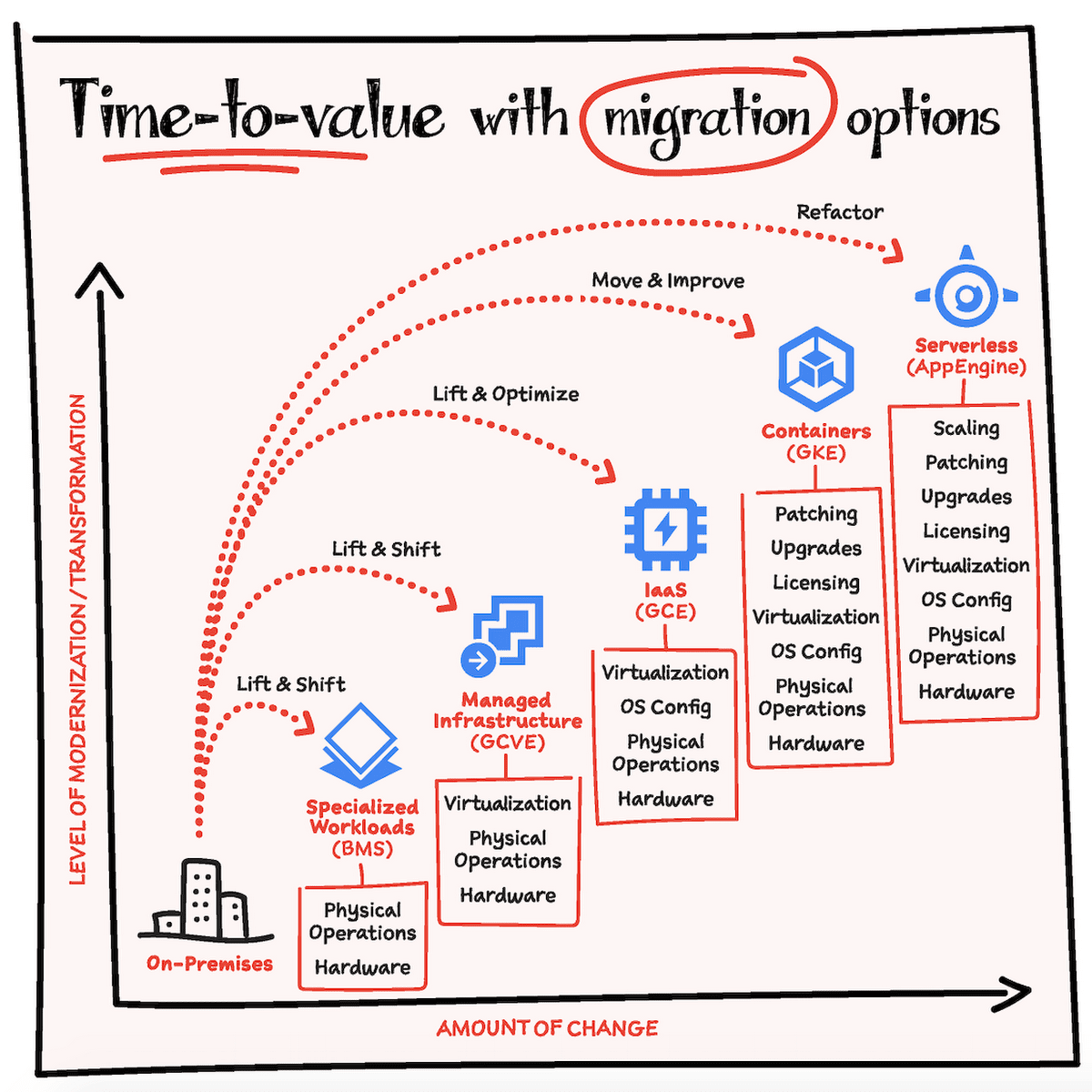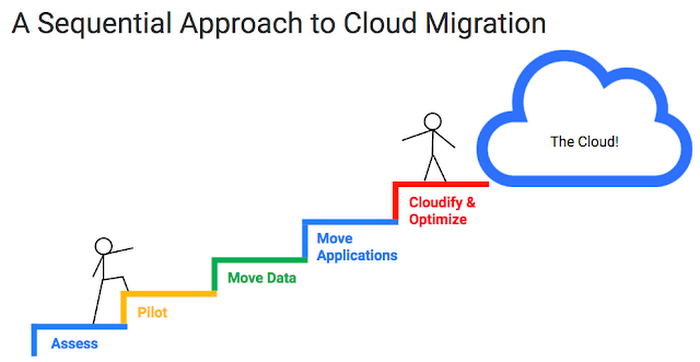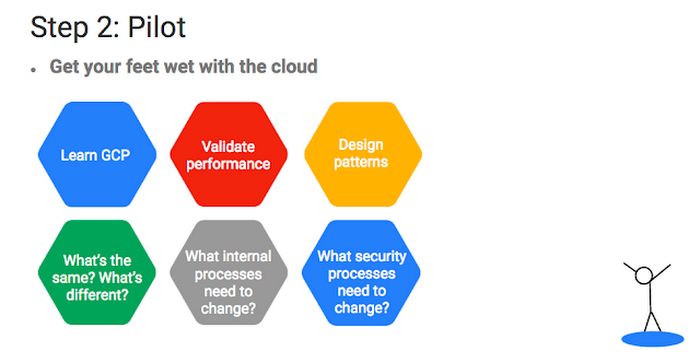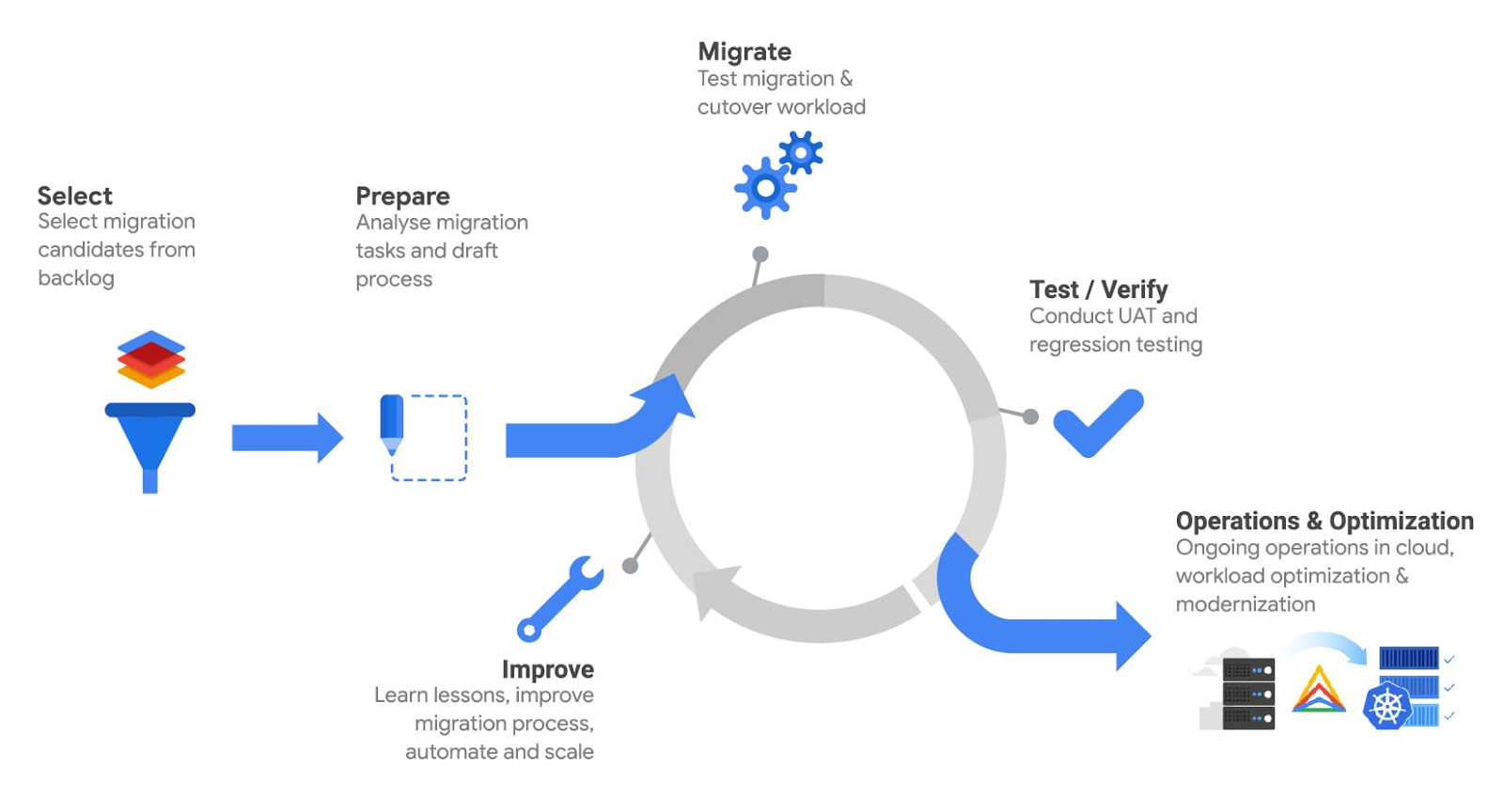What is could migration?
The cloud migration strategy is the plan an organization makes in the prep stage before moving its data and applications from on-premises architecture to the cloud. It can also involve moving from one cloud environment to another.
Different migration strategies require different preparation time and resources engaged in enacting the migration plan.
Why is the strategy of cloud migration important?
Having a game plan for migrating to the cloud is crucial for a successful cloud migration.
Cloud migration strategies
There is a whole range of approaches to cloud migration and the choice of the right one depends on a number of factors, including the current state of your infrastructure, and how much you are looking to spend to achieve the desired goals. The proper understanding of each strategy’s benefits and shortcomings is essential to choosing a successful cloud migration strategy.
The three most common ones include: “Lift and Shift” (rehosting), “Improve and Move” (replatforming), and “Rip and Replace” (refactoring). Let’s take a look at each of the migration strategies’ pros and cons.

Lift and Shift
The Lift and Shift (also called rehosting) is seemingly the easiest and quickest migration strategy to execute. It involves transferring resources without making changes.
In the case of rehosting, workloads are moved from the current environment to the target environment without introducing changes or with only necessary modifications to ensure the application functions properly in the cloud. This option is suitable for applications that don’t require business-related alterations.
It simply involves lifting the resources and shifting them to a new storage location without spending time on modernising the application. Maintenance or development teams can continue using the same tools, ensuring workflow continuity.
However, applications migrated using the lift and shift strategy won’t fully utilise the potential of the public cloud. Unadjusted workloads won’t harness the capabilities of managed services, horizontal scaling, or detailed budget management mechanisms.
Pros of rehosting
- It is a good solution for small organizations with a limited number of workloads
- Good for organizations which use virtual machines extensively
- Easy and quick
- Cheap at the initial stage
Cons of rehosting
- Limited flexibility
- Retains all legacy issues, including outdated software
- Doesn’t take advantage of all cloud capabilities
- Can be expensive in the long run
Improve and Move
Improve and Move (replatforming) is a cloud migration strategy that involves modernising application elements during migration. The aim is to adjust workloads for the new environment’s services, enabling them to leverage the potential of native cloud services. This strategy allows enhancements in scalability, availability, performance, cost-efficiency, and portability.
The migration process under this strategy takes more time than lift and shift and requires teams to acquire new skills. Application elements need to be examined and often require editing of the source code. While implementing necessary changes for cloud workload operation, certain application areas can also be improved.
Migration with the improve and move strategy entails greater financial and time investments. Therefore, it’s crucial to calculate the return on investment before deciding to initiate the process.
Pros of replatforming
- Enables companies to leverage the potential of cloud native services
- Allows the organization to improve performance of its infrastructure
- May prove more cost-effective in the long run
Cons of replatforming
- More time consuming than simple rehosting
- Requires more advanced skillsets
- Usually requires more upfront financial investment.
Rip and Replace
Rip and Replace (refactoring) is a cloud migration strategy that entails rewriting the application entirely to adapt it to cloud services. This involves withdrawing and retiring the existing version (the so-called drop-and-shop approach) and launching a new, cloud-native version, in many cases built from scratch. This strategy is typically chosen for applications with high maintenance costs requiring substantial refactoring.
Building a new version of the application allows complete customisation to meet the requirements and capabilities of managed cloud services. This provides extensive scalability options, and opportunities for automating various processes, for example by leveraging machine learning capabilities of the cloud. Thanks to cost monitoring tools that cloud providers offer, this migration strategy also offers detailed budget management capabilities.
This approach is the most time-consuming and costly way to conduct a migration. Both system administrators and developers should be involved in the process. Everyone involved must be aware of the target environment’s requirements and acquire the skills necessary to build a cloud-native application.
Pros of replatforming
- Good for organizations growing quickly and looking for flexible scaling options
- A good opportunity to automate processes, including AI automation
- Allows organizations to fully benefit of cloud computing
Cons of replatforming
- The most time consuming of cloud migration strategies
- Requires the highest engineering skill set and involvement of several IT departments
- Can be costly, especially if not planned properly.
Cloud migration process
There is no one-size-fits-all approach to cloud migration. While some organizations benefit from quick and easy solutions, other might use the migration strategy as a good opportunity to modernize processes and apps.
In other cases, cloud migration is an opportunity to retire part of the old infrastructure, build new apps from scratch, or opt for a Software as a Service or Infrastructure as a Service option instead.
Regardless of which method you decide to use in your migration process, your cloud migration strategy should include these basic steps. Let’s take a quick look at the five step of the cloud migration process.

Assess
Cloud migration planning should start with an in-depth assessment of your current environment. You will need to examine your hardware and performance requirements, your users, app dependencies, licensing options, as well as compliance requirements.
You need to assess which of your resources fall into each of the following buckets:
- Easy to Move
- Hard to Move
- Can’t Move.
This usually requires an overhaul of your current cloud server requirements and your app and resource performance. This is a stage where you could benefit from the expertise of a cloud specialist.
Pilot
This is an often overlooked step of cloud migration, but experts agree it is a vital one. Rather than trying to move all your apps and resources to the cloud environment in one go, start with just one or two apps. It takes time to learn the ins and outs of any cloud environment and this is the step you can do it safely.

Make sure the apps are performing as expected, measure costs. At this stage, you should also and establish a rollback plan if there’s an unexpected failure of the new configuration.
Move data to the cloud environment
Opinions are split on what should be moved first: data or applications. If your applications use a lot of data to run (e.g. video streaming), then data should definitely go first. This way you will have all your resources in place when you launch your first app in the new cloud environment.
At this stage you need to consider different Cloud Storage options. As some can be costly, you might want a cloud specialist prepare you a cost analysis based on your resources. If you would like to receive a cost analysis from a certified Google Cloud Partner and learn where and how to reduce costs of your cloud storage, contact our team.

Move applications to the cloud
This is arguably the most important part of the process. It is also why cloud migration strategy is crucial to fully utilize the benefits of the cloud platform you have chosen.
Run and optimize
Once all your assets are in the cloud, it is time to start using it and optimize the resources. There are many aspects you may want to consider. Some of these include:
- optimizing the use of cloud resources by moving static assets to cloud storage.
- monitoring cloud usage
- creating redundancies in various cloud zones and regions to ensure business continuity.
Cloud migration – good practices
Regardless of which cloud migration strategy you decide to follow, there are several good practices to follow in the migration process. If you follow them, you reduce the risk of a failed migration.
1. Define your goals
The first step of cloud migration is to bring all the stakeholders together and make sure they agree on the goals of cloud migration. It’s also good practice to have cloud migration strategy goals formulated clearly and making everyone familiar with them. The list of goals should contain a set of metrics and KPIs that will help you measure the process of your cloud migration.
2. Create a roadmap for each asset
Any cloud migration plan starts with a detail overhaul of your current infrastructure and assets. Every app, service and database need to be catalogued to make sure you don’t overlook a crucial component. Make sure you know how assets depend on one another to prepare a timeline of what needs to move and when.
Ideally, you should be able to divide your migration into batches or waves.

Applications are rarely stand-alone pieces. They need the proper scaffolding to function. A team of trained cloud engineers should make a list of components and designate the less-critical ones that can be moved first. The timeline should also specify when legacy assets should be retired.
The more detailed the roadmap you follow while developing your cloud infrastructure, the smaller the risk of an unexpected roadblock.
If you want to make sure your organization sticks its landing in the cloud, learn about Landing Zone – a modular cloud infrastructure that makes migration to the cloud environment safe. It is particularly useful for companies taking their first steps in the cloud.
3. Calculate costs
If there is one thing that most companies agree on is that calculating the cost of the cloud infrastructure can be tricky. That’s especially true when your organization is moving from an on-prem environment.
Some aspects that are of no concern in the on-prem infrastructure, such as idle resources, are of key importance in the cloud. You do not want to pay for resources you don’t use. Make good use of the pricing calculators and read up on how to optimize cloud cost.
4. Plan for the best, prepare for the worst
There are some aspects of cloud migration that are hard to predict or protect against. Even the best migration strategies need backups and failsafes for unforeseen circumstances.
It is important to create a sound and functioning Disaster Recovery Plan that you periodically update to ensure business continuity.
5. Provide your employees with the right skillset
Make sure you provide ample training to your engineers on the cloud technology of your choosing. Use a trusted source to gain up-to-date knowledge, as cloud technology keeps evolving.
6. Keep records
Cloud migration requires a lot of resources, and involves multiple stakeholders., One of the key factors influencing cloud migration success is the documentation of the process. Your goals, plans, roadmaps, resources etc. should be well documented at every step of the migration process.
7. Verify each stage
It is good practice to test and measure performance at each stage of the migration process.. This way you will be able to pinpoint the source of the errors immediately.
The testing process should be a continuous endeavor and should end only after all assets have been moved to the cloud and the old infrastructure decommissioned.
8. Stay updated
Many organizations migrate to the cloud to remain competitive and gain access to state-of-the-art technologies. In order to fully leverage the potential of cloud migration, you need to stay on top of its developments.
A Cloud partner can be an invaluable source of cutting-edge knowledge about the current trends. If you have any questions about cloud migration, get in touch with our cloud specialists.
